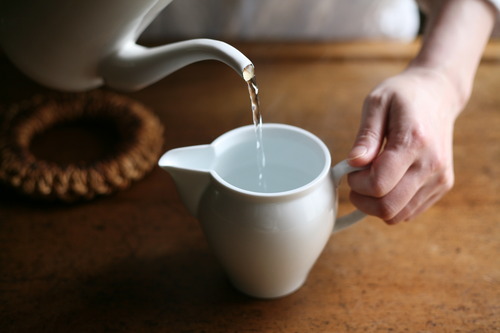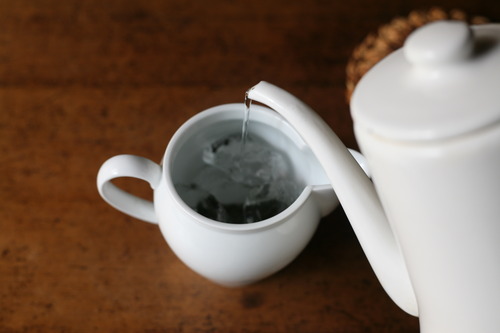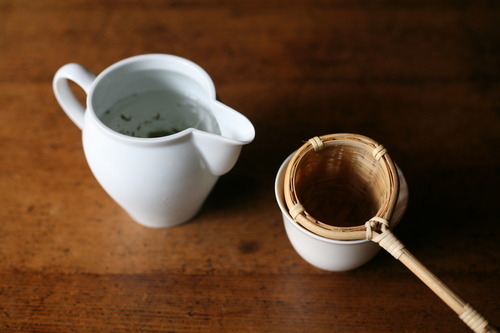


[Enjoying Japanese Tea]
The day of "hachiju hachiya" falls on or around May 2, counting 88 days from Risshun. This is the beginning of the new tea season, which occurs only once a year in Japan. Sprouts that have survived the harsh winter are tender, less astringent, and rich in theanine, a sweet component. The youthful green color characteristic of new tea is beautiful to the eye, and the blue aroma and sweetness that wafts through the nose are exceptional.
Tea was introduced to Japan during the Nara and Heian periods. It is believed to have been brought to China by Japanese envoys to the Tang Dynasty and resident monks who brought back advanced Chinese culture. In those days, it was drunk as an analeptic and to restore one's health, so much so that it was said that "drinking new tea will keep you disease-free for a year" and "new tea is good for longevity."
With the mainstream use of easily available teas in plastic bottles, people are less likely to brew tea at home using a kyusu (Japanese teapot). How about tasting Japanese tea once again, just as you enjoy coffee or tea? Carefully brewed, high-grade sencha has a delicious broth-like flavor.
When making sencha, the temperature of the water and hot water is important. Most tap water in Japan is soft water, so if you remove the chlorine, it is suitable for making tea. Genmaicha and hojicha are best brewed with hot water around 90°C, sencha and deep steamed sencha at 70-80°C, and gyokuro at a lower temperature of around 50°C. The more advanced sencha teas use lower temperature water. Gyokuro, in particular, is at a lower temperature to prevent the delicate tea leaves from being burned.
When you don't have a thermometer and temperature control is troublesome, a "yuzamashi" comes in handy. It is said that if the boiling water is around 90 degrees and the water is poured from a high place, the temperature drops by 10 degrees. For genmaicha, simply take hot water from the kettle and pour it into a kyusu from a high place to reach the proper temperature of 70 to 80 degrees Celsius. For sencha, if you pass the hot water between the yuzamashi and the teacup several times while warming the teacup, it will reach the proper temperature of around 70 degrees Celsius. You can choose the type of tea leaves and the temperature at which to brew the tea, depending on whether you want an astringent tea with catechins or a tea full of delicious amino acid flavor. The shape of the "yuzamashi" is also very convenient for holding dressing, making it a frequently used tool.
Another recommendation is homemade cold-brewed tea. Although the idea of cold brewing may seem time-consuming, here is one easy way to do it. Put the tea leaves (about 5g) in a yuzamashi, place ice on top of it, and slowly pour hot water (120-150g) from the top as if hitting the ice. Let it sit for 15 seconds and it is done. If you strain it through a tea strainer and drink it in your favorite wine glass, you will discover a different aroma and taste.
Finished tea leaves can be dried and used as deodorant or reused in cooking. Tea leaves are also rich in nutrients such as carbohydrates, proteins, fats, vitamins, and minerals. Many of the ingredients are not soluble in water, so nutrients other than vitamin C and minerals remain in the tea husk. If you dress the tea shells with ponzu vinegar and add sesame seeds or dried bonito flakes to add flavor, it is a dish that goes well with sake. How about rediscovering the deliciousness of Japanese tea in your home time?
Azmaya's Kyusu and Yuzamashi
https://www.shokunin.com/en/azmaya/kyusu.html
Tsukiusagi's Slim Pot
https://www.shokunin.com/en/tsukiusagi/
Susumuya's Teacup
https://www.shokunin.com/en/susumuya/yunomi.html
Kiya's Bamboo Tea Strainer
https://www.shokunin.com/en/kiya/chakoshi.html
References
http://www.ocha.tv/how_to_brew/water_and_temperature/
http://5106.jp/japanese-tea/4297/